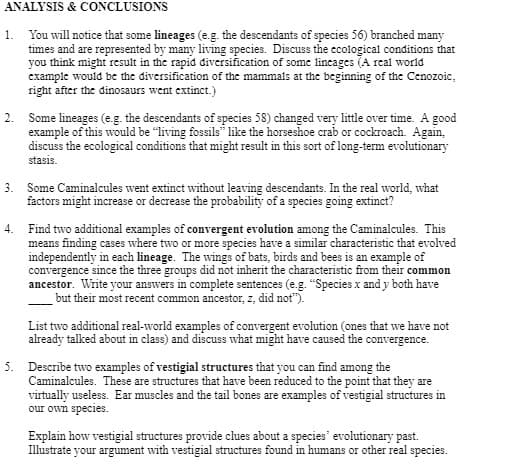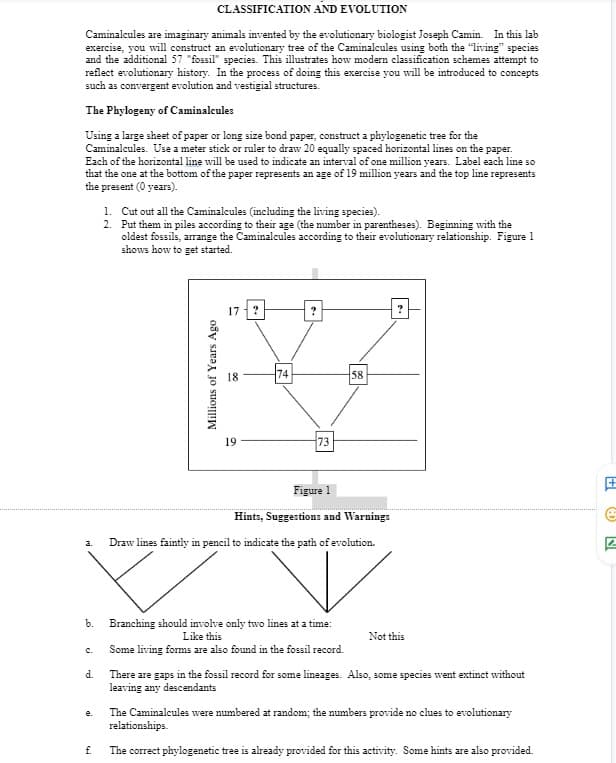1. You will notice that some lineages (e.g. the descendants of species 56) branched many times and are represented by many living species. Discuss the ecological conditions that you think might result in the rapid diversification of some lineages (A real world example would be the diversification of the mammals at the beginning of the Cenozoic, right after the dinosaurs went extinct)
1. You will notice that some lineages (e.g. the descendants of species 56) branched many times and are represented by many living species. Discuss the ecological conditions that you think might result in the rapid diversification of some lineages (A real world example would be the diversification of the mammals at the beginning of the Cenozoic, right after the dinosaurs went extinct)
Biology: The Dynamic Science (MindTap Course List)
4th Edition
ISBN:9781305389892
Author:Peter J. Russell, Paul E. Hertz, Beverly McMillan
Publisher:Peter J. Russell, Paul E. Hertz, Beverly McMillan
Chapter24: Systematics And Phylogenetics: Revealing The Tree Of Life
Section: Chapter Questions
Problem 1ITD: The phylogenetic tree for 12 cat species (Felidae) reproduced at right was assembled from molecular...
Related questions
Question

Transcribed Image Text:ANALYSIS & CONCLUSIONS
1. You will notice that some lineages (e.g. the descendants of species 56) branched many
times and are represented by many living species. Discuss the ecological conditions that
you think might result in the rapid diversification of some lineages (A real world
example would be the diversification of the mammals at the beginning of the Cenozoic,
right after the dinosaurs went extinct.)
2.
Some lineages (e.g. the descendants of species 58) changed very little over time. A good
example of this would be "living fossils like the horseshoe crab or cockroach. Again,
discuss the ecological conditions that might result in this sort of long-term evolutionary
stasis.
3. Some Caminalcules went extinct without leaving descendants. In the real world, what
factors might increase or decrease the probability of a species going extinct?
4. Find two additional examples of convergent evolution among the Caminalcules. This
means finding cases where two or more species have a similar characteristic that evolved
independently in each lineage. The wings of bats, birds and bees is an example of
convergence since the three groups did not inherit the characteristic from their common
ancestor. Write your answers in complete sentences (e.g. "Species x and y both have
but their most recent common ancestor, z, did not").
List two additional real-world examples of convergent evolution (ones that we have not
already talked about in class) and discuss what might have caused the convergence.
5. Describe two examples of vestigial structures that you can find among the
Caminalcules. These are structures that have been reduced to the point that they are
virtually useless. Ear muscles and the tail bones are examples of vestigial structures in
our own species.
Explain how vestigial structures provide clues about a species' evolutionary past.
Illustrate your argument with vestigial structures found in humans or other real species.

Transcribed Image Text:CLASSIFICATION AND EVOLUTION
Caminalcules are imaginary animals invented by the evolutionary biologist Joseph Camin. In this lab
exercise, you will construct an evolutionary tree of the Caminalcules using both the "living" species
and the additional 57 "fossil" species. This illustrates how modern classification schemes attempt to
reflect evolutionary history. In the process of doing this exercise you will be introduced to concepts
such as convergent evolution and vestigial structures.
The Phylogeny of Caminalcules
Using a large sheet of paper or long size bond paper, construct a phylogenetic tree for the
Caminalcules. Use a meter stick or ruler to draw 20 equally spaced horizontal lines on the paper.
Each of the horizontal line will be used to indicate an interval of one million years. Label each line so
that the one at the bottom of the paper represents an age of 19 million years and the top line represents
the present (0 years).
1. Cut out all the Caminalcules (including the living species).
2.
Put them in piles according to their age (the number in parentheses). Beginning with the
oldest fossils, arrange the Caminalcules according to their evolutionary relationship. Figure 1
shows how to get started.
17
?
Millions of Years Ago
18
74
58
19
73
Figure 1
Hints, Suggestions and Warnings
a.
Draw lines faintly in pencil to indicate the path of evolution.
b. Branching should involve only two lines at a time:
Like this
Not this
C.
Some living forms are also found in the fossil record.
d.
There are gaps in the fossil record for some lineages. Also, some species went extinct without
leaving any descendants
e.
The Caminalcules were numbered at random; the numbers provide no clues to evolutionary
relationships.
£.
The correct phylogenetic tree is already provided for this activity. Some hints are also provided.
1+
Ⓡ
N
Expert Solution
This question has been solved!
Explore an expertly crafted, step-by-step solution for a thorough understanding of key concepts.
This is a popular solution!
Trending now
This is a popular solution!
Step by step
Solved in 2 steps

Knowledge Booster
Learn more about
Need a deep-dive on the concept behind this application? Look no further. Learn more about this topic, biology and related others by exploring similar questions and additional content below.Recommended textbooks for you

Biology: The Dynamic Science (MindTap Course List)
Biology
ISBN:
9781305389892
Author:
Peter J. Russell, Paul E. Hertz, Beverly McMillan
Publisher:
Cengage Learning

Biology Today and Tomorrow without Physiology (Mi…
Biology
ISBN:
9781305117396
Author:
Cecie Starr, Christine Evers, Lisa Starr
Publisher:
Cengage Learning

Biology: The Dynamic Science (MindTap Course List)
Biology
ISBN:
9781305389892
Author:
Peter J. Russell, Paul E. Hertz, Beverly McMillan
Publisher:
Cengage Learning

Biology Today and Tomorrow without Physiology (Mi…
Biology
ISBN:
9781305117396
Author:
Cecie Starr, Christine Evers, Lisa Starr
Publisher:
Cengage Learning